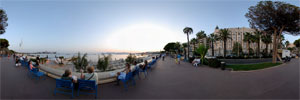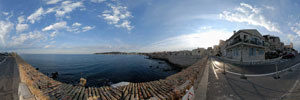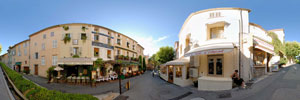Nice Panorama
- News :
- French Riviera :
- Provence :
- Var :
- Leisure :
- Economy :
- Gastronomy :
- Sport :
- Accommodation :
- Tourism :
- Site Map :
Cannes’s region on the French Riviera : a virtual visit
Cannes
is an elegant city of international repute. It is located along the Mediterranean and is protected by Mistral Esterel. Cannes therefore benefits from an exceptional climate and summer vacationers will be able to enjoy its sandy beaches. This dynamic city has established itself internationally through its many festivals, including the most famous one dedicated to cinema. The visit of the city enables to discover its many facets.
Along the famous Croisette, a broad avenue lined with palm trees by the sea, tourists will not fail to admire the grand hotels and palaces with legendary names: Majestic, Carlton, Martinez, Noga. La Croisette and Rue d’Antibes (parallel road), offer a succession of luxury boutiques and jewelers. At the end of the Croisette, the residential area of California is home to beautiful mansions dating from the pomp of the 19th (Castle Louis XIII, Villa Fiesole, Villa Rothschild). We can also admire the yachts and sailing boats on the docks of Port Canto.
Cannes has remained until the 19th century, a small fishing village around Mont Chevalier (historic Suquet). It was only then that the English aristocracy (among others with Lord Brougham) has led to the current development of the city. The historic district of Le Suquet retains the charm of Provencal villages: the streets are narrow and buildings with colorful shutters are glued to each other.
The islands of Lerins (Sainte-Marguerite and Saint-Honore) are facing the city. The beautiful beaches and walks you bring disorientation. Sainte-Marguerite, the largest, has a park of 170 hectares and some of the most beautiful beaches of the Cote d’Azur. The island is famous for its Fort Vauban, who was a royal prison and housed, among others, the man in the Iron Mask. The fort also houses the Maritime Museum with its collection of underwater archeology. St. Honore is the property of the monks and houses a Cistercian monastery dating from the feudal era (13th and 15th cloister, walkway). Visitors should be respectful of the quiet of the monastic life and unspoiled natural environment.
Antibes
would have been based in the 5th or in 4th century BC by Phocaeans of Marseille. Antibes was then an episcopal see between the 4th and the 13th century. It is at this time that the episcopal see was transferred to Grasse.
The Grimaldi family, native of Genoa and ally of the Angevins, received the fief of Antibes of the Pope of Avignon in refund of a debt. They became established there towards the end of the 14th century. The Dédition of Nice in the 14th brought a border near Antibes. The efforts of fortifications became intensified during the rivalries between Francois Ier and Charles the Fifth and continued till the end of the administration of Henri IV. At the beginning of the 17th, Henri IV having bought the city to the Grimaldi of Antibes, those settled down in the castle of Cagnes-sur-Mer until the French Revolution.
The dismantling of the fortifications of Antibes began in 19th century to accompany an increasing urbanization. At the end of the 19th, the sea resort of Juan-les-Pins was created. Nowadays, we can visit number of monuments bound to this history. Let us quote, for example, the Fort Carré built in 16th century under Henri II and developed in the end of 17th century under Louis XIV by Vauban and the Castle of Grimaldi (15 and 16th centuries) which shelters nowadays the Picasso museum. The visit of the old town and the ramparts offers a beautiful sight on the cape of Antibes. We can flanner on the covered Provencal market or visit the Peynet museum.
The port Vauban, one of the biggest pleasure port of Europe, welcomes every spring during the "Sails of Antibes" an important Classic gathering of Yachts in the Mediterranean Sea. Every summer, the Festival of jazz of Juan-les-Pins takes place and fireworks are organized by the biggest artificiers. The World Festival of Underwater Pictures is held in autumn. The visit of the Marineland of Antibes allow, youngs as big, to admire unique entertainments with killer whales, dolphins and sea lions.
Mougins
is situated between Cannes and Grasse on the Napoleon road. The old village was strengthened in the Middle Age. In the 11th century, the count of Antibes gave Mougins to the abbey of Lérins, which kept it until the Revolution. During the war of succession of Austria (18th century), the village was destroyed by a fire and plundered by the austro-Sardinian armies.
The main economic activity of the 19th century was the floral production (rose and jasmine) for the perfumers of Grasse. From half of the 20th century, Mougins became a great tourist and artistic place of the Côte d’Azur. Nowadays, Mougins welcomes on its territory near 20% of the technopole of Sophia-Antipolis.
Around Monaco
Around Nice
Around Cannes
Around Grasse


